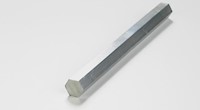| Items |

2024-T4H-1875
Aluminum Hexagons - Series 2024
|

2024-T4H-250
Aluminum Hexagons - Series 2024
|

2024-T4H-3125
Aluminum Hexagons - Series 2024
|

2024-T4H-375
Aluminum Hexagons - Series 2024
|

2024-T351H-500
Aluminum Hexagons - Series 2024
|
|
Material
|
N/A
Aluminum
|
|
Shapeform
|
N/A
Hexagons
|
|
Series
|
N/A
2024-T4
|
N/A
2024-T4
|
N/A
2024-T4
|
N/A
2024-T4
|
N/A
2024-T351
|
|
Grade
|
N/A
2024
|
|
Temper
|
N/A
T4
|
N/A
T4
|
N/A
T4
|
N/A
T4
|
N/A
T351
|
|
Size
|
N/A
3/16 inches
|
N/A
1/4 inches
|
N/A
5/16 inches
|
N/A
3/8 inches
|
N/A
1/2 inches
|
|
Size
|
N/A
0.1875 inches4.7625 mm
|
N/A
0.25 inches6.35 mm
|
N/A
0.3125 inches7.9375 mm
|
N/A
0.375 inches9.525 mm
|
N/A
0.5 inches12.7 mm
|
|
Estimated Weight
|
N/A
0.0365 lbs/ft0.054317986 kg/m
|
N/A
0.065 lbs/ft0.09673066 kg/m
|
N/A
0.1015 lbs/ft0.151048646 kg/m
|
N/A
0.1461 lbs/ft0.2174207604 kg/m
|
N/A
0.2598 lbs/ft0.3866250072 kg/m
|
|
Estimated Weight per 12' Bar
|
N/A
0.438 lbs0.1986734712 kg
|
N/A
0.779 lbs0.3533484796 kg
|
N/A
1.218 lbs0.5524755432 kg
|
N/A
1.754 lbs0.7956010696 kg
|
N/A
3.118 lbs1.4143011032 kg
|
|
ASTM Specification
|
N/A
AMS 4120 AMS-QQ-A-225/6 ASTM B211 UNS A92024
|
|
Ultimate Strength
|
N/A
68 ksi
|
|
Yield Strength
|
N/A
47 ksi
|
|
Elongation percent in 2 inches
|
N/A
19
|
|
Hardness Brinnel Number
|
N/A
120
|
|
Ultimate Shearing Strength
|
N/A
41 ksi
|
|
Fatigue Endurance Limit1
|
N/A
20 ksi
|
|
Modulus of Elasticity2
|
N/A
10.6 x 104 ksi
|
|
Resistance to Corrosion - General3
|
N/A
D
|
|
Stress Corrosion Cracking4
|
N/A
C
|
|
Workability (Cold)5
|
N/A
C
|
|
Mechinability
|
N/A
B
|
|
Brazeability6
|
N/A
D
|
|
Gas Weldability7
|
N/A
C
|
|
Arc Weldability8
|
N/A
B
|
|
Resistance Spot and Seam Weldability9
|
N/A
B
|
|
Applications
|
N/A
Truck wheels, screw machine products, aircraft structures
|
|
Density
|
N/A
0.100 lbs/in³
|
|
Specific Gravity
|
N/A
2.78
|


